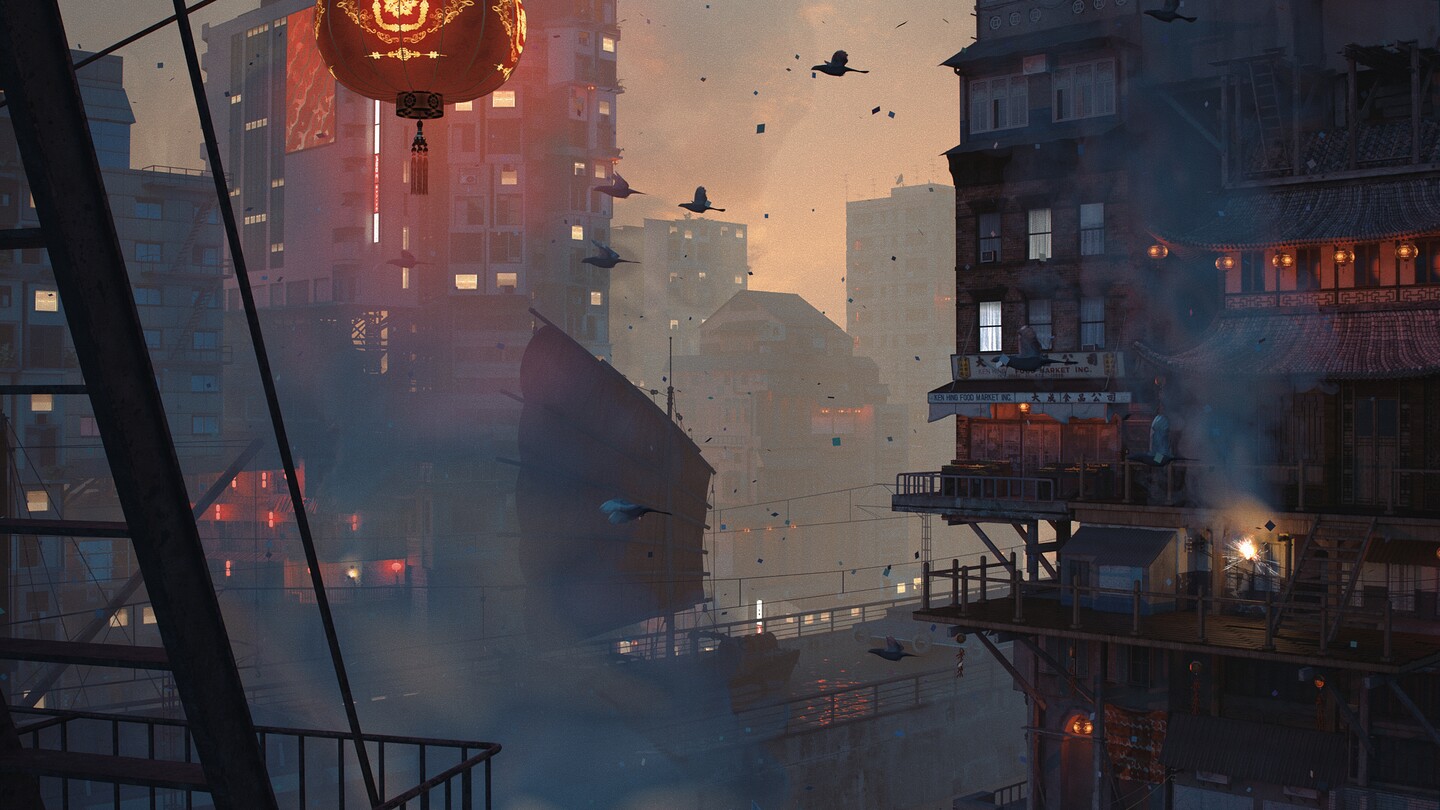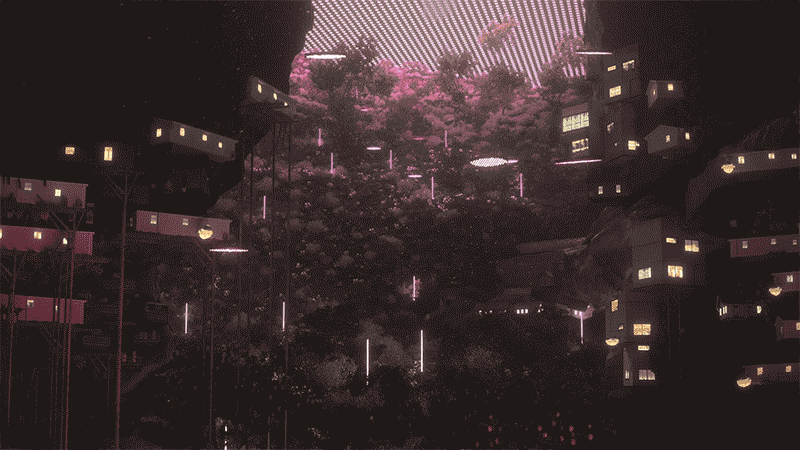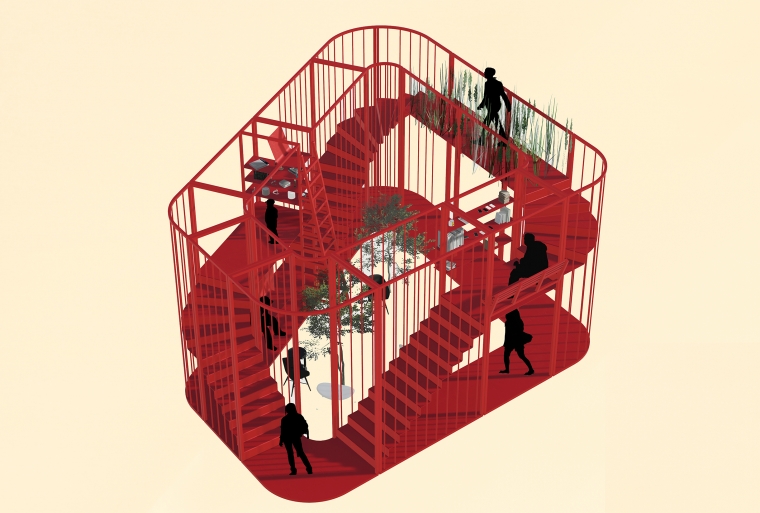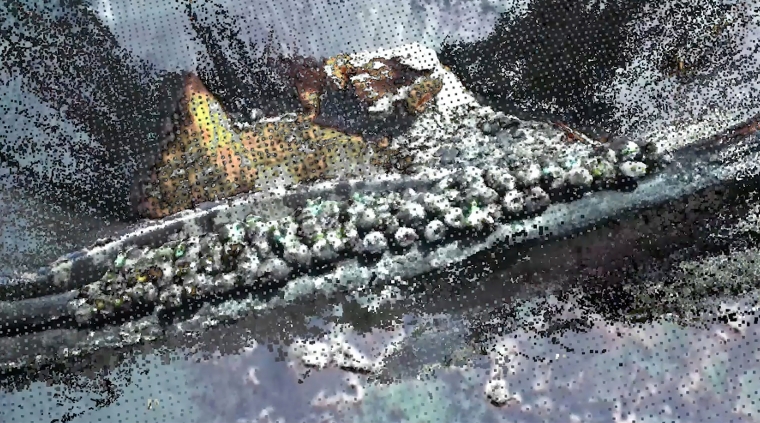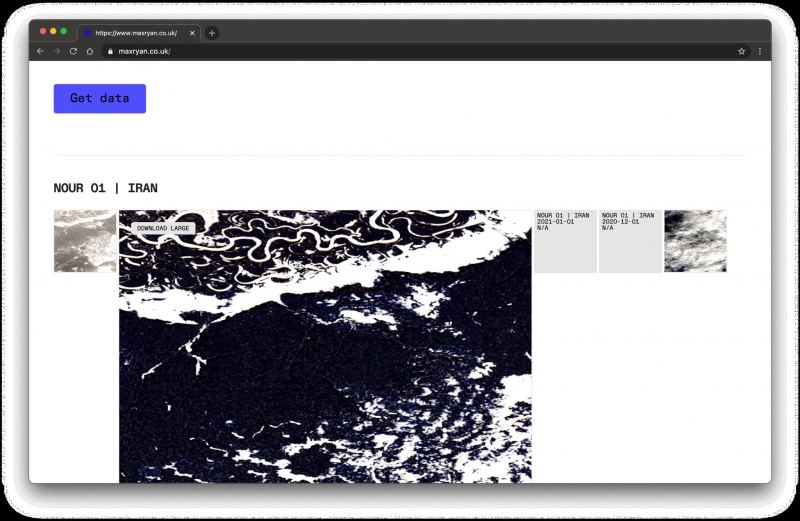Cascades is a collaboration between maat and e-flux Architecture within the context of the exhibition X is Not a Small Country, featuring fiction by Rahel Aima, Xenia Chiaramonte, Richard Cottrell, Kabage Karanja and Stella Mutegi, Case Miller, Ingo Niermann, Bahar Noorizadeh, and Feifei Zhou.
The Earth never stops moving. Neither do the people, the things, the lives, the materials, the ideas that live upon it. Roads, paths, channels, networks, lines—all these are built to facilitate, but also control such mobilities. For whom or what can go where is always subject to the question of why, how, and at what cost. Borders, tariffs, sanctions, treaties, policies, agreements, conventions, and the like are the chess pieces of politics that contour, but can never fully determine the relations, the trajectories, the affinities of that which they purportedly govern or rule. Any semblance of stability or order is nothing but a matter of illusion.
Globalization is a concept that emerged at a particular moment in history to identify a particular set of geopolitical relations and economic ideologies crystalized into spatial form. While the processes it describes have arguably existed ever since the world was first thought, it is only since the development of late capitalism and the fall of the Soviet Union that globalism came to describe a hegemonic, and indeed, perhaps more importantly, global ideology. But if the Cold War defined the Earth’s magnetic field, what took its place in the global imaginary was merely a hallucinatory projection of north.
Less than twenty years after the purported triumph of capitalism, the Earth’s geomagnetic field was thrown back into disarray. The financial crisis of 2008 reorganized the world’s flows and called for measuring yet again the declination of its historical compass – the distance between the north that is true, and that which gravity attracts to. But the events that followed and define the global present have proven, in their volatility and unaccountability, that new ways of measuring, new ways of sensing, new ways of detecting, new ways of relating are increasingly necessary. For while the ground beneath our feet never stops moving, agency hinges on the ability to calibrate the speed of the self and the collective to that of its environment.
Trade wars. Structural inequality. Refugee crises. Climate breakdown. Emergent nationalisms. Rising fascisms. Unbridled racism. A global pandemic. What else? Transnational flows of people, ideas, and resources are being actively disrupted and reordered in ever more unpredictable ways, with little sign of stopping in the future. But as pathways once taken for granted are abruptly obstructed, others previously thought inconceivable appear to suddenly open up. What might feel to some to be an ongoing contraction of the globe and its veins of circulation might really be the growing pains of things, people, and ideas moving in different directions, and at different speeds.
In a time increasingly defined not by linear narratives or logics but rather transactional opportunism, black swan events, cascade effects, and unintended consequences, what has been brought into relief are the rifts and shifting alliances among governments, corporations, and citizens – and between value systems, economic agendas, and political expediencies. In the absence of grand historical narratives, fiction serves as a potent means to infuse the present with potentiality. By turning to other worlds, other times, other places, other realities, fiction prepares us for an encounter with perhaps the only thing we can know will come – the unknown.
...
The Red City of the Planet of Capitalism
Bahar Noorizadeh

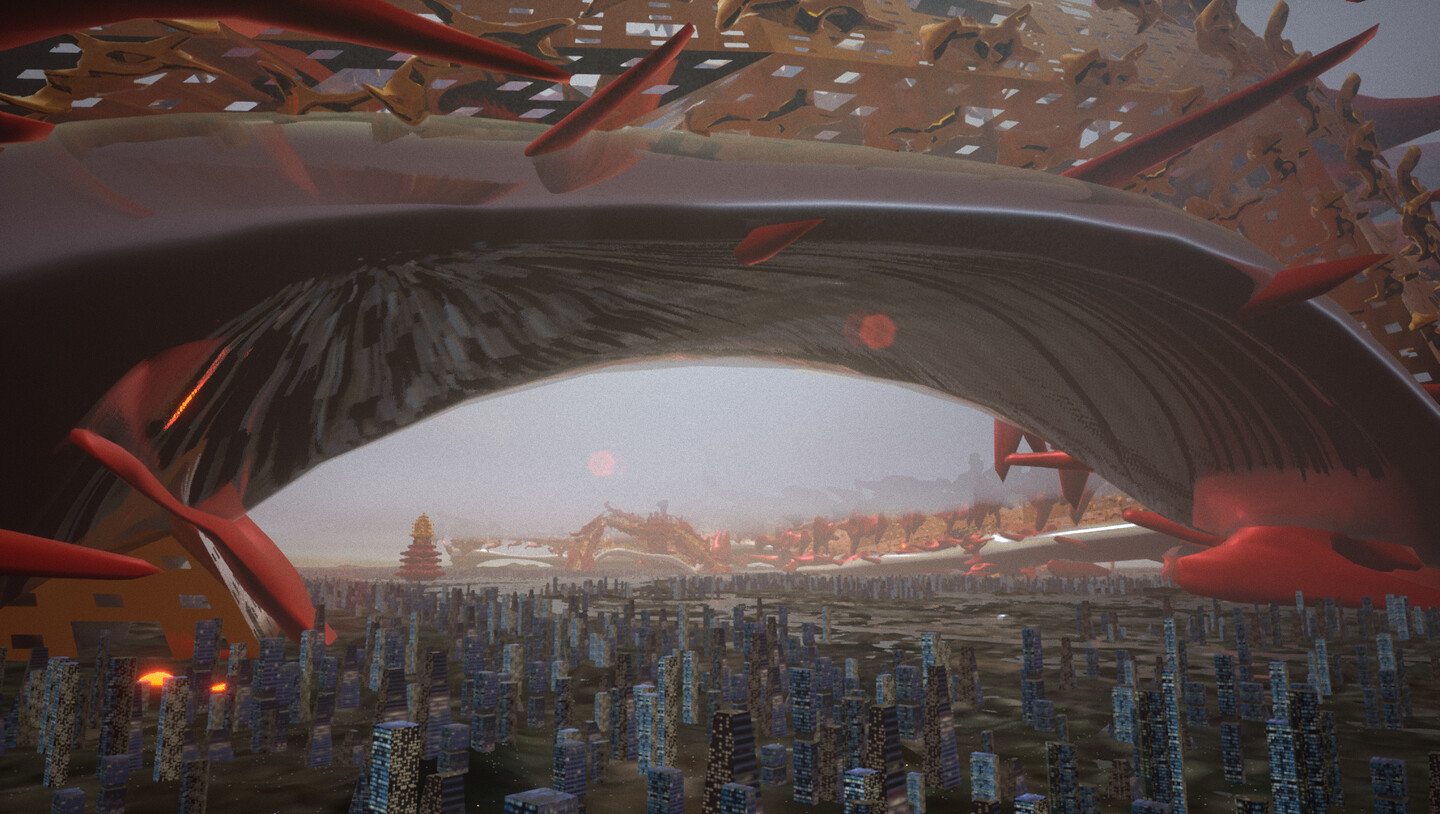
Bahar Noorizadeh, "The Red City of the Planet of Capitalism", film still, 2021. Animation by Ruda Cabral.
When the Contagion reached Hong Kong in 1997, Philip Tose traveled to 2047 to take a lump sum loan from himself. Most people blamed the magnitude of the economic crisis on the flame-out of his notorious investment company—Peregrine—which he had shepherded for a decade through a combination of what his rivals bitterly called senseless and aggressive investment. Indeed, Peregrine had underwrote several Asian markets with atrocious human rights records (Myanmar and Vietnam, for instance) and flagrantly found its political allies in post-Tiananmen China. When asked about their opinion on the latter events, Tose’s partner called them mere “hiccups,” an opportunity to ride the wave of depression.
…
I truly believed that Hong Kong’s economic freedom would lead to socio-cultural freedom. It used to set an example for the rest of the world. This was the reason behind seeking asylum in the future Hong Kong from the atrocious regulations in America at the time. But this?! I'd rather spend my retirement in the prospering Hong Kong of 1947, now that, unfortunately, America is no longer an option for me.”
Bahar Noorizadeh is a filmmaker, writer, platform designer, and PhD candidate at Goldsmiths, University of London. Her work has appeared in the Tate Modern Artists’ Cinema Program, DIS Art, Transmediale, and the German Pavilion at the 2020 Venice Architecture Biennale, among others.
...
Jubilee
Case Miller

Case Miller & Claire Cochran, “Leaving”, 2021.
Part 1
“What we consider our core tradition of moral and political theory today springs from this question: What does it mean to pay our debts? … Maybe nobody really owes anything to anybody. Maybe those who pursue profit for its own sake have it right after all.”
— David Graeber, Debt: The First 5000 Years (New York: Melville House, 2011), 197.
It is that particular time in the morning when the sky and the fields and the moisture and the atmospheric gases are still moving slowly. If you looked, you would think bands of colour could almost be observed. The irrigation vapours hang above the ube leaves, trying to claim that slice of the sky and turn it slightly blue.
But, honestly, they can only achieve this victory with the help of the crops. So, when the fields stop, running headlong into the orange mountains to the south, the moisture meets the desert and moisture always comes up short. Eventually everything mixes. Particulates up the chain have to negotiate. Working together under uneasy terms, their compromises determine the colour of the day.
…
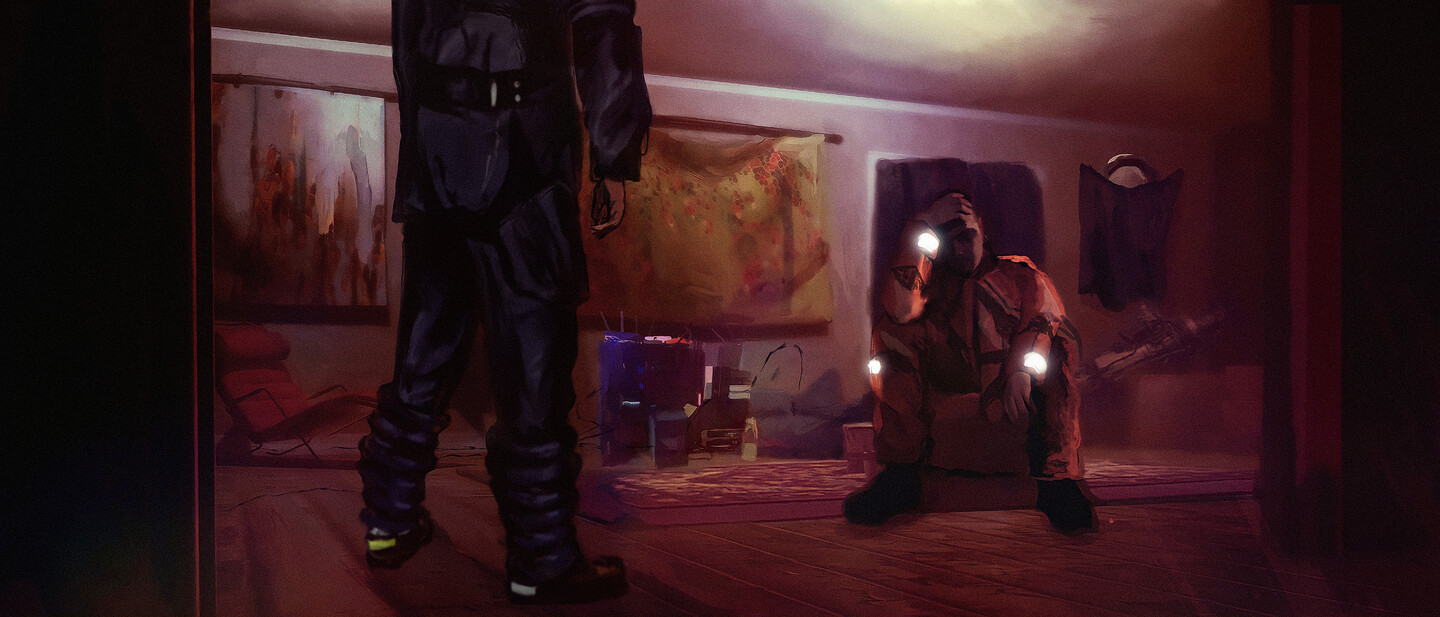
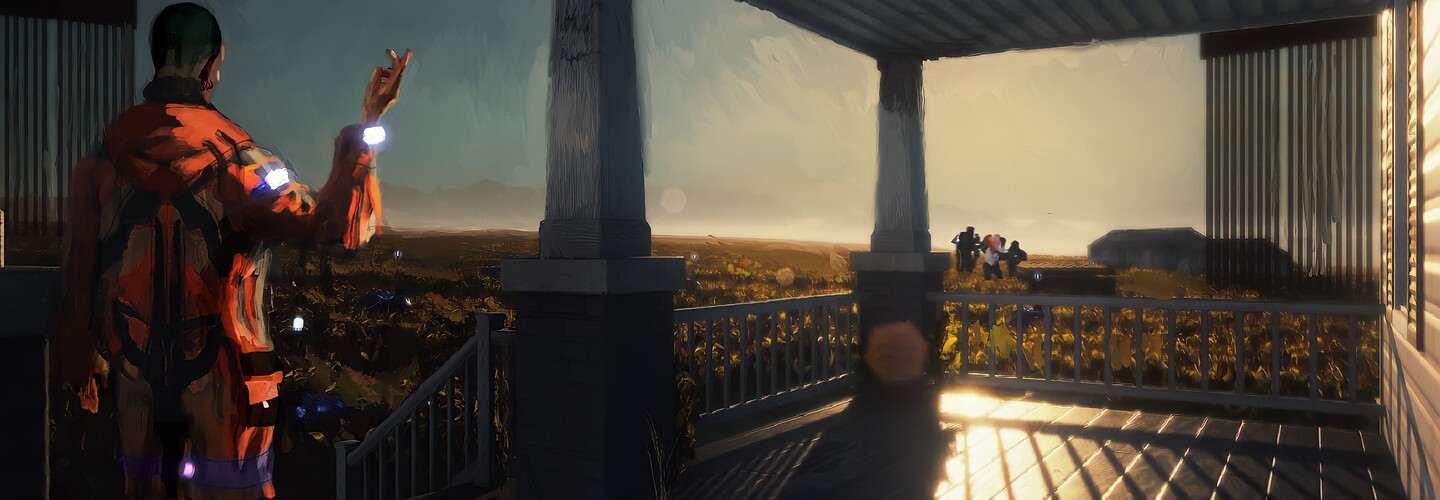
...
The Cave Canon
Kabage Karanja and Stella Mutegi
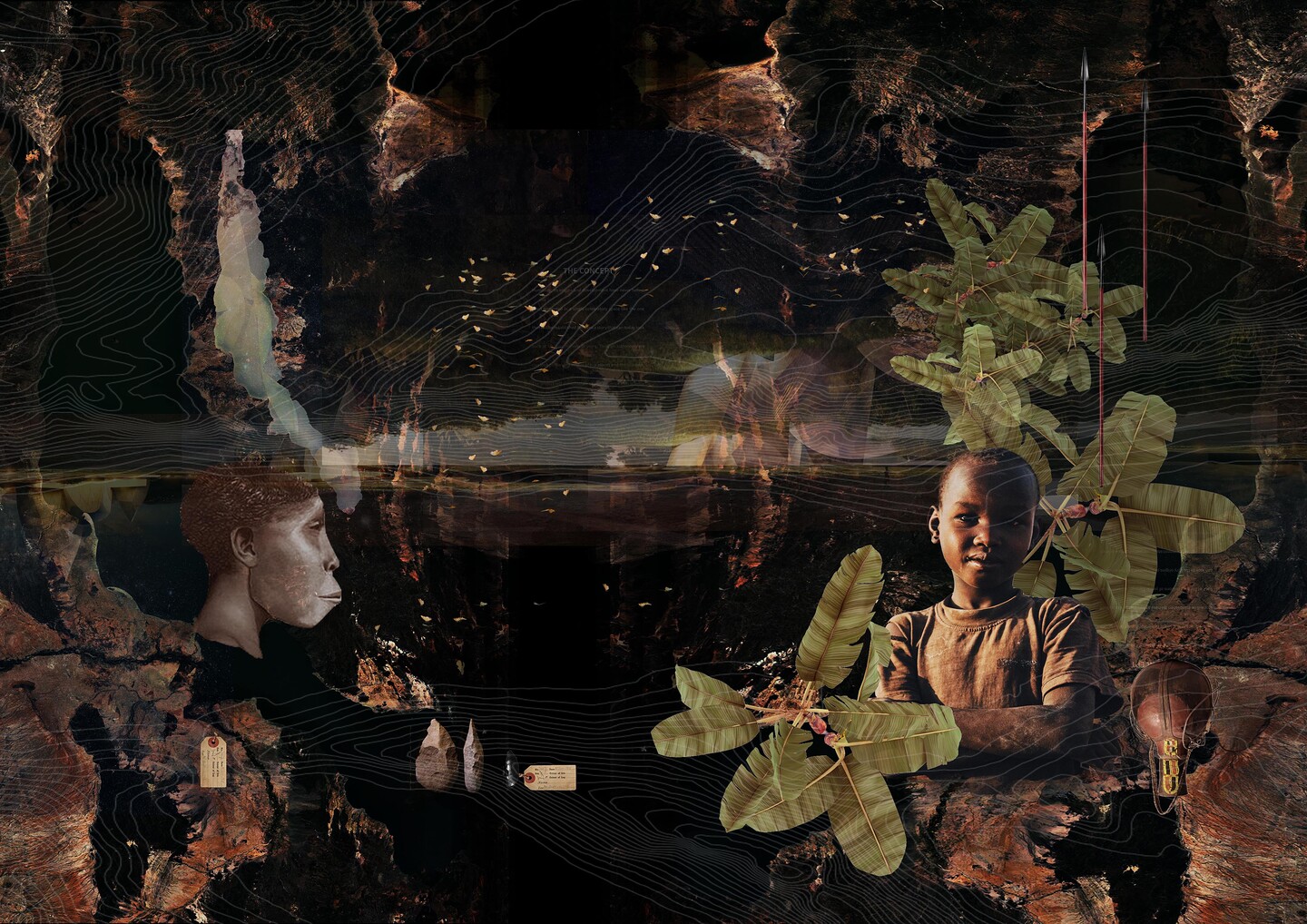
Kabage Karanja and Stella Mutegi, “Origin is forever”, 2020.
“This can’t be architecture…” Kali wrote on his yellow layout paper while gripping his clutch pencil. He sat obtuse against his chair looking at the ceiling moving his eyes across the steel GI conduit pipes that snaked over the studio room, feeding the gallery swivel lights with geothermal power. “Ehh! Kali, what’s up now?” Mumbi asked, as she peered over her monitor screen tilting her head to glance at him. “Ok Mumbi, angalia,” he said in Swahili, or “look here,” to get her attention as he lunged forward. “I know we signed to be the ‘enviable’ architects of record here to deliver the Origin Museum, and yes, it is a dream brief and our partners are insanely talented, but in all honestly it seems to mean nothing when you consider the intended or unintended disconnection of our lead shapeshifting architects with what is really happening here on the ground, in our so called cradle of mankind.”
He continued: “No amount of deezeening, archiloving, archdailying, or pintresting of the latest African works by Francis Kere, Mariam Kamara, or Kunle Adeyemi, nor the so-called ‘project immersion workshops with the locals,’ will equip them to embed this project in the culture. It just feels like they’re exhuming some opaque colonial justification to generate an architecture, postulated from the global north to attract foreign tourist footfall to hear the story of humanity’s emergence from Africa. So, in the end, we can only just sit and enjoy the show, as we, the proverbial ‘architects of record’ get paid to plant this intricately beautiful aberration of our culture onto the land.”
…
|
Kabage Karanja is a director and founder of Cave_bureau, starting the practice in 2014 alongside Stella Mutegi. He is a qualified architect in the UK and Kenya.
|
Stella Mutegi is a director and founder of cave_bureau, starting the practice in 2014 alongside Kabage Karanja. She is a qualified architect in Kenya.
|
...
Root Seeker
Feifei Zhou

Scene inside an “infrastructure farm”. Image by Feifei Zhou, 2021.
I’ve been walking along this mountain belt for hours. I think I’m getting close – at least, according to the footage my drone captured yesterday. There were no pathways throughout, but I’m determined to find it.
I’m at the northwest side of Yunnan Province, “where heaven is,” my granddad used to say. He was from a village in Yunnan, but I grew up as a city girl in the East. I’ve only seen photos of what it used to look like here from his worn photo album. In these photos, the landscapes were covered by all kinds of vegetation, so dense that you could hardly see the sunlight shining through. The large variance in mountain elevations once created the most biologically and culturally diverse areas in China. But now I’m stepping on dry soil, feeling somewhat melancholic.
Some years ago, they cut down the last bit of the rainforest left in the Amazon. Nowadays you can hardly find a natural forest anywhere on Earth. Deforestation led to soil erosion and desertification, which made it almost impossible for agriculture to take place on land. Farming has completely moved indoors.
…
Soil trading and transportation suddenly became one of the world’s most prosperous industries; every country wanted to be part of it. Nonetheless, most developers of the infrastructure farms were owned by developed countries, and they would make profits from the large price gap between buying cheap fertile soil from developing countries and selling the crops at scale.
Feifei Zhou is a Chinese-born artist and architect. She co-edited "Feral Atlas: The More-than-Human Anthropocene" (2020) and was a guest researcher at Aarhus University Research on the Anthropocene.
...
Greetings from the Undergrowth
Xenia Chiaramonte
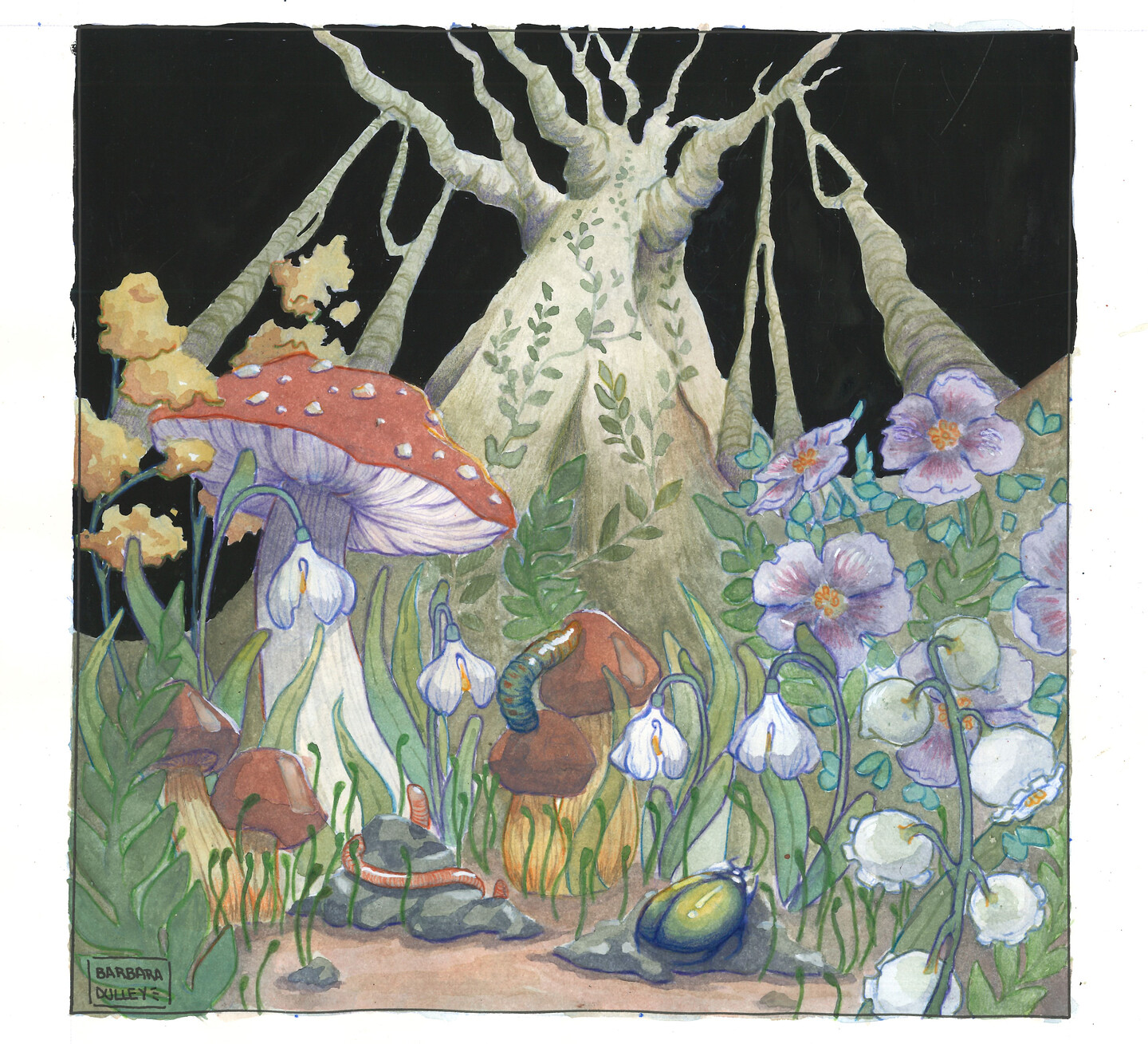
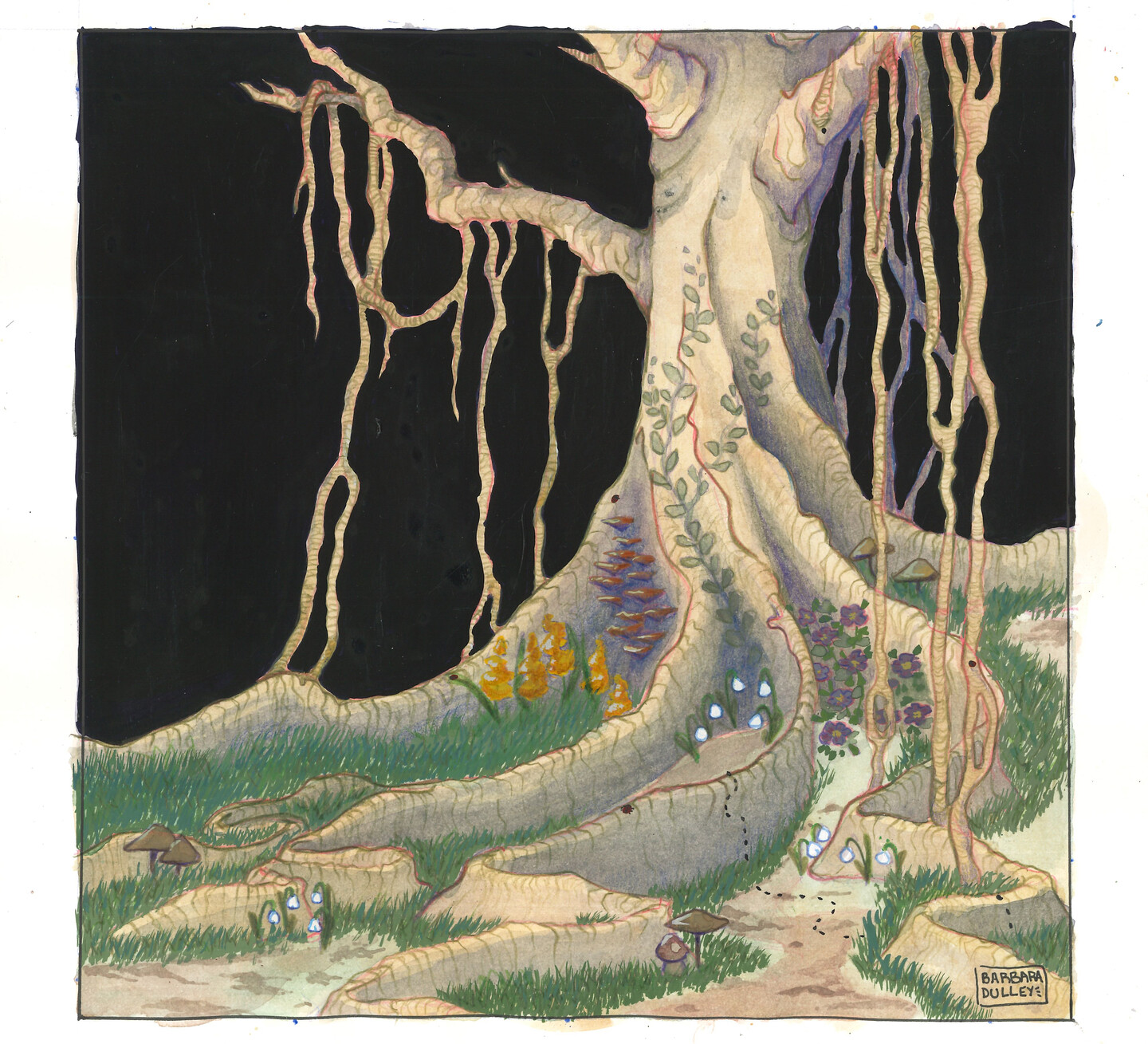
Barbara Dulley, “Undergrowth”, 2021.
Barbara Dulley, “Magnolia”, 2021.
I have to write a story I am not entitled to tell. A parallel botanical story of myself. A story that I was made to tell.
Once upon a time, I was with a plethora of very well-known scholars and they were stepping on me. I was probably considered too young, a novice. Undergrowth. Now, I take the opportunity to tell my own story. In all honesty, I feel no pleasure in doing it. I would have loved to avoid this need. By nature, I am shy and humble. Yet, I am compelled to say the truth about myself. I repeat, I would not do it but I risk creating more embarrassment and being perceived as haughty if I do not. So, here we are. This is my story. To be precise, it is our story.
…
History always moves in circles. We say things that others before us have said. Because we collaborate, we think together. Above us we recognize only the trees. They are old and have seen it all. They survive for millennia and almost do not know death. And if they know it, now we can say it loudly, how much more life they can create. What humans call God we call trees.
Xenia Chiaramonte is a jurist, socio-legal scholar, and author of "Governare il conflitto: La criminalizzazione del movimento No TAV" (Governing conflict: The Criminalization of the No TAV Movement, 2019). She is an ICI Berlin Fellow 2020–2022.
...
The Rift
Richard Cottrell
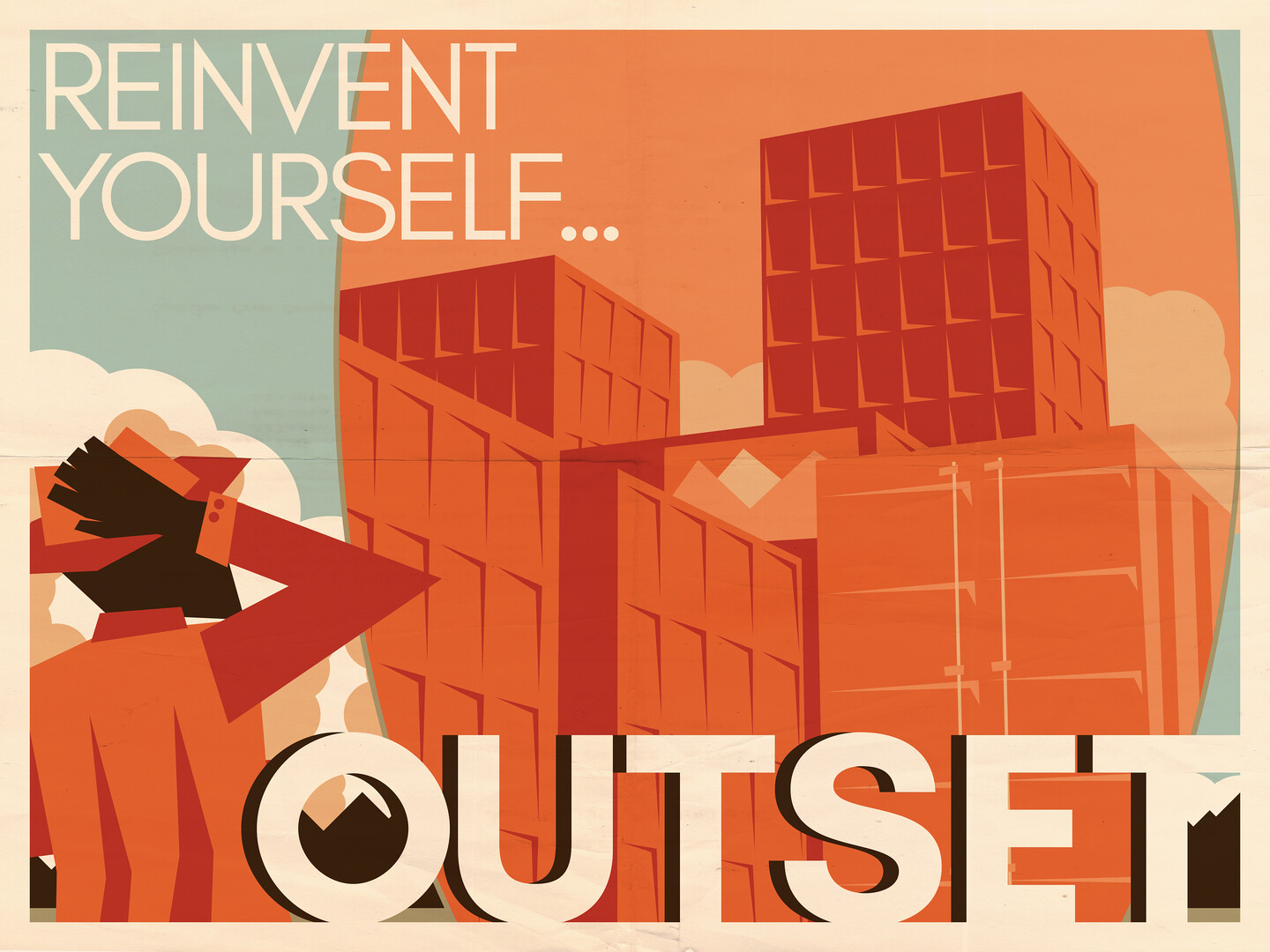
Richard Cottrell, “Outset Travel Poster”, 2021.
The North American Rift was discovered shortly after the end of the Great War, when it bisected a tractor on the morning run. Initial, informal tests revealed a stable two-sided, two-dimensional ovoid opening in the air that linked a field in the Midwest of the United States to an arid region in some unknown place. Early information about the discovery was slow and disjointed in its spread. In the confusion, a local surveying firm hastily organized an expedition to gather some information. Their results were astounding—an entirely new, uninhabited world, with a commensurate bounty of resources:
The stars in the sky are foreign from our own, but in all other ways the region of investigation seems to be adjacent to the geography and clime of our home country. With no sign of other inhabitants, the terrain is lush with untapped resources and hints of exotic new material. A figure of ambition would have unparalleled opportunity to establish themselves and make something new.
Emboldened by the promise of unclaimed fortune, as well as the apparent lack of official response, the surveying firm purchased the land around the rift and started to issue land vouchers and industry permits for extracting resources—minerals, lumber, livestock, crops—on the other side. Word of this started to spread quickly. Enterprising businesses, investors, and individuals all began to rush to the rift in a bid to stake their claim on the newfound territory.
With this sudden migration, the government was forced to take notice. Still embroiled in negotiations surrounding the Treaty of Versailles, the uncharted lands on the far side of the rift were marked as a simple unorganized territory. The firm that owned the surrounding land was issued a charter, allowing them to oversee administrative functions as well as provisions for handling travel from one side to the other. Its small team of surveyors reorganized into the Manifest Destiny Trading Company, and the initial camps that surrounded both sides of the rift quickly grew into settlements, towns, and thrumming cities: Culmination in the United States, and Outset in the frontier.
…

Richard Cottrell is an independent game designer, architect, and researcher. His original games include Anarchy, Ammunition, & Ambition and Soldiers of Fortune.
...
Terror’s Child Muses
Ingo Niermann
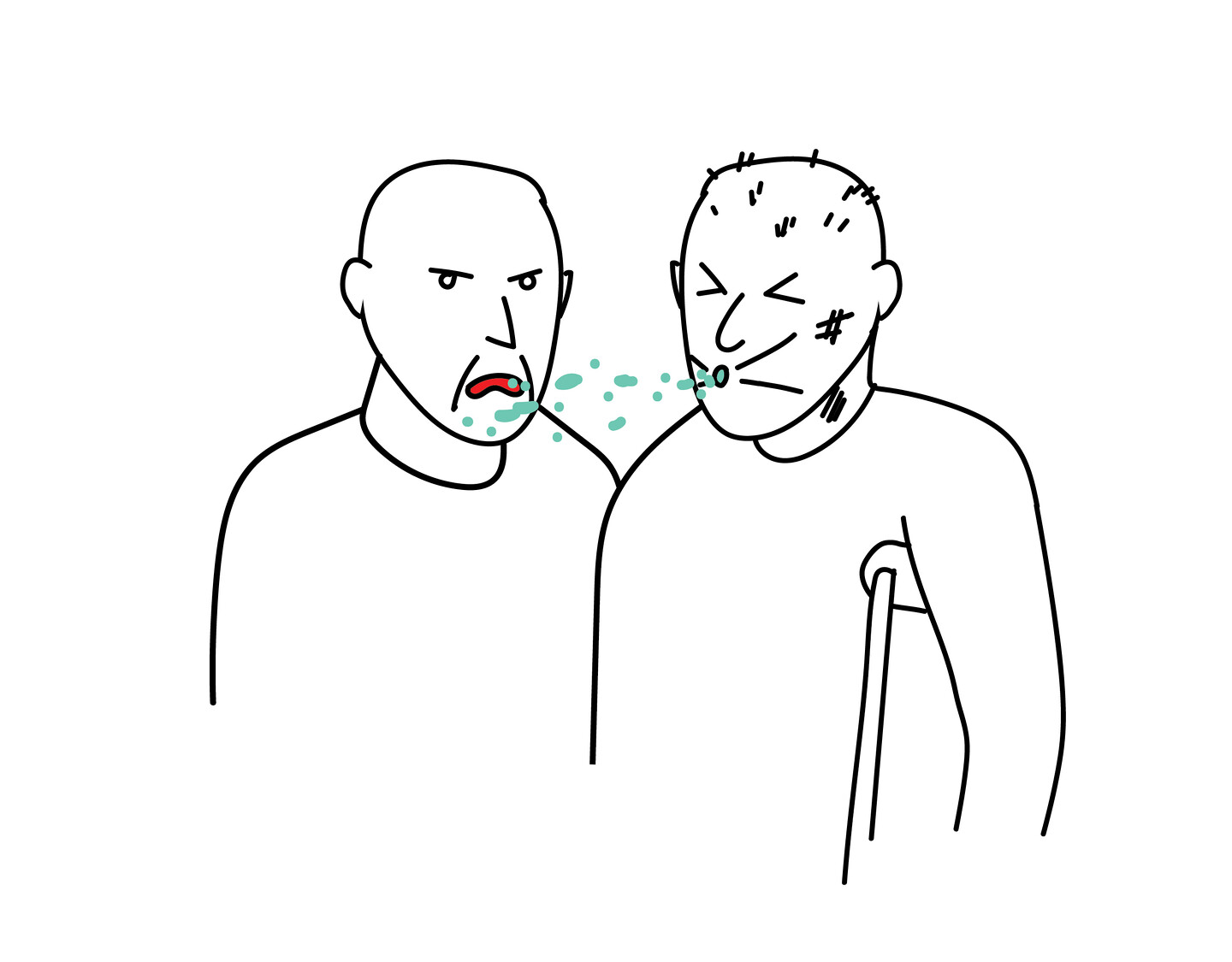
"Old and terminally ill climate activists tried to infect themselves with SARS-CoV-2 in order to infect as many other people as possible before death took them anyway. They called themselves Bats because SARS-CoV-2 allegedly spread to humans from bats." Bat, from Deutsch Süd-Ost, 2020. Illustration: Mad Smell.
The first people I fell in love with were terrorists. The German fear of the communist Red Army Fraction (RAF) peaked in 1977, when I turned eight years old. Since then, every time I accompanied my mother to the post office, I went straight to the wanted poster next to the door and checked it for new faces. The terrorists could be anywhere, and surely we wouldn’t notice them as, of course, they would appear very different by now. But I knew they wouldn’t attack me or my parents since we weren’t rich or powerful.
The first TV news I remember were about the RAF kidnapping of Hanns Martin Schleyer, president of the Federation of German Industries and former member of the SS. I saw Schleyer with his sad puppy-dog eyes and counted the days of his kidnapping, spellbound. It was the terrorists who had made that ruthless capitalist and antisemite so heartily helpless. I didn’t want him to ever be free again. It would undo his softness and turn him again into a grim, loud man.
At school, physical violence was a thing among boys, but in the RAF, the proportion of men and women was pretty equal. These women with long straight hair and men with beards and big glasses appeared to me as perfect teachers. Their composed, waiting gazes met me from another world, and at any time they could cross mine. I dreamt of being allowed to stay with them—just me. The war on terror was the new Cowboys and Indians, and I wanted to be with the outnumbered, fearless Indians and their noble cause. Big letters at the bottom of the poster warned “Watch out, firearms!” But I knew they wouldn’t harm me, and the police couldn’t harm me either. I was too young. I counted as innocent, no matter what I would do.
…
But could anti-terrorism finally become so effective that terrorism stops altogether? Or could it become far too obvious that all that keeps terrorism going is the outrageous anti-terror response? To evaluate these scenarios, we have to consider how terrorism and the definition of terrorism might evolve in the future.
Ingo Niermann is a writer and the editor of the Solution Series. His recent publications include Solution 295–304: Mare Amoris and the video series Deutsch Süd-Ost (at steirischer herbst '20).
...
Moon Rose
Rahel Aima

Damask Rose. Photo: Lucia Condac/Wikimedia Commons.
On June 26, 2029, the Director launched the new moon. It was named Ruda, after the ancient pre-Islamic lunar deity. It made the bioluminescent coastline—seeded with the appropriate algae just a few years ago—ripple a ghostly lilac instead of the usual blue. The idea was that Ruda would appear on the horizon at precisely the moment that the old moon entered total eclipse, during what would be the largest lunar eclipse of the twenty-first century. But under the benevolent glow of Ruda, there would never be darkness again.
Nobody could forget the total solar eclipse three summers ago, on the day that the Kushner accords were signed. Its path of totality moved in an unerringly straight line, from the Ash-Sharmah resorts at the very tip of the headland where the Gulf of Aqaba met the Red Sea all the way to Tabuk, on the far edge of the megacity. There were nervous murmurs among the older locals, the ones who tilled the roses, or gülfields. What was left of them anyway, after most of the community was resettled to the Ash-Sharat highlands in anticipation of the summit that would create a new TransJordanian state. These days, they mostly supported the population of the megacity, or worked at Halat al Ammar on the former Jordanian border, now home to the Dumah military superbase.
Eight minutes after Ruda was launched, the moon burnt saffron, then sickly vermillion. Like a bloody burnt jalebi, my stomach grumbled. My bunkmate Sabzal was transfixed, and spent the next few months singing Urdu ghazals about the moon. You wouldn’t expect that voice coming out of a man like that, built like that asparagus-looking guy on the ration cans. He never did the catchy numbers, only those bleak tanhaai ones. Years later, when he returned to Quetta, he wrote to tell me that they had named their firstborn daughter Mahbano after the moon that night.
That blood moon changed the roses forever.
…
Rahel Aima is an art critic, writer, and editor based between Brooklyn and Dubai.
...
Spaceship Hour
Jimenez Lai
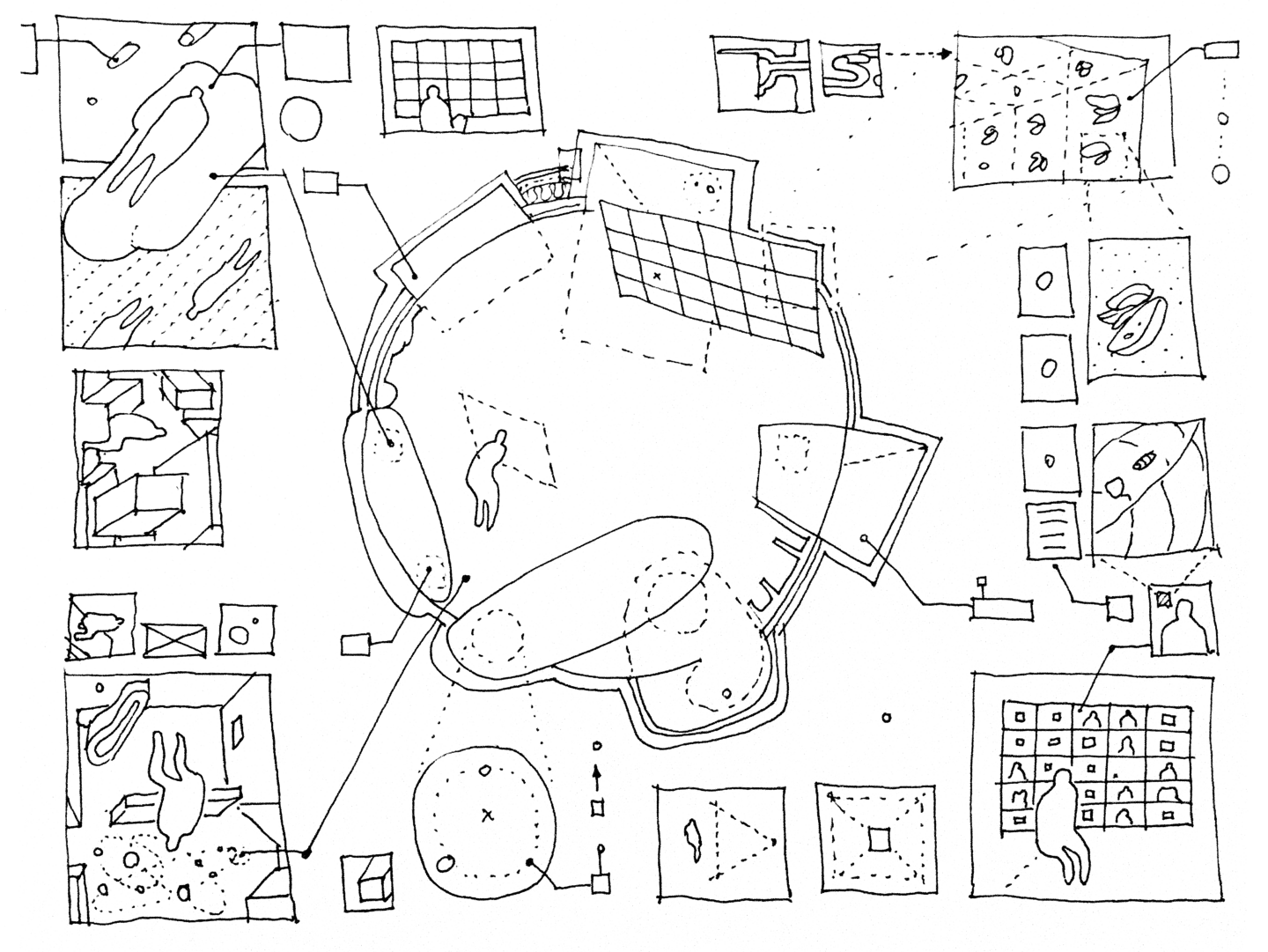
Jimenez Lai, “Spaceship Hour”, 2021.
Life Support
What time is it? 6am? 10pm? I am once again waking up to the reflection of my face against the perpetual darkness outside, peppered by countless stars and planets in every direction. Timekeeping has been both difficult and somewhat pointless since I left earth. The only thing on this spaceship that really still operates on a “24-hour” cycle is my human body. I eat regularly, I use the restroom regularly, I work regularly, I exercise regularly, and I sleep regularly. I just have no idea what time it is anymore, unless I check my immaculate clock. I simply pass time regularly.
Life on this emergency survival pod has been… lucky. I am one of the very few who managed to escape the world-ending event that happened some time ago. How long ago? Sorry, I can’t remember. Months? Years? Could be years. Definitely months. I can check. I mostly make out the passing of larger units of time by watching the plants and fish grow in my in-unit micro-farm. My spaceship’s life-support agriculture and aquaculture system uses an efficient ultraviolet and hydroponic self-feeding and insta-harvesting automation technology carefully designed for a 2000-calories daily intake cycle. I have been able to eat a very nutritionally balanced, albeit bland, healthy diet.
Whenever I complete a bowel movement, the biomatter gets directly suctioned back into the compost that grows the food. Once a month I get to eat one tilapia. I have to keep at least thirty-six alive in the tank at all times. Sometimes I am a little sad to eat the only other earthlings that keep me company. Alongside my diet, it is vital to maintain a consistent fitness regiment, since my body easily weakens in an environment without gravity. Back on earth, if you told me I’d be eating some kind of a spinach-beet-parsnip-legume concoction as my primary meal for the rest of my life and doing resistance-band daily workouts, I might have said “kill me now.” But, here we are, and I am happy to be alive. The self-sustaining life-cycle on this living module means that I can remain alive “indefinitely.”
…
On rare days, though, we do have a good time eating together, reminiscing about life on earth, laughing about TV shows we both watched. My tilapia colony has regrown, my greenhouse is reseeded, and my spaceship is mostly back in full function. There is no longer just darkness against my reflection, but a glowing red ball. I no longer think about timekeeping solely for medical reasons, but sometimes for social reasons too.
Jimenez Lai is the founder of Bureau Spectacular, a design studio founded in 2008 he leads with his partner Joanna Grant.
...
Cascades is a collaboration between maat and e-flux Architecture.
Curated by Aric Chen, with Martina Muzi, X is Not a Small Country – Unravelling the Post-Global Era (maat, 18/03 – 06/09/2021) includes nine newly created projects by international practitioners working across the fields of design, architecture and art who investigate, articulate and critique the current convoluted state of the world from multiple geographic perspectives.


